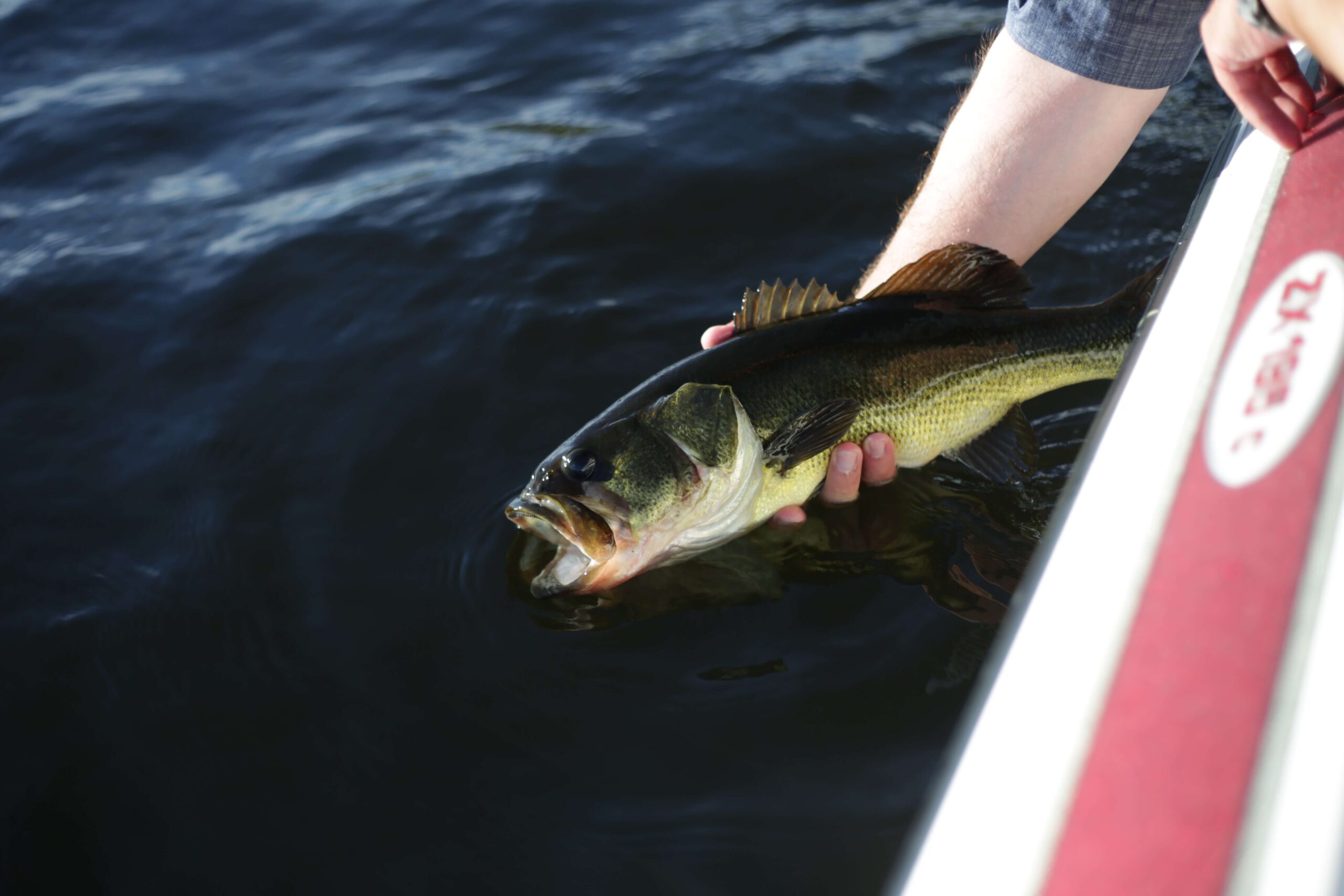Can You Eat Bass? Myths & Misconceptions Explained!

When most people think of fishing, they think of bass fishing. It’s easily the most popular fish to catch and is stocked in lakes and rivers around the world, making it one of the most plentiful fish to seek. Not only that, but bass are some of the easiest fish to catch, no matter your skill level.
With that said, many anglers today are dedicated to saving bass for catch and release only. It’s sort of an unwritten rule among anglers that you don’t eat them and instead use them for sport only. It’s a large reason why you see so many fishermen let the bass free after catching them.
Of course, that begs several questions by those that don’t fish for sport — are you allowed to eat bass? People all over the world are constantly wondering if:
- bass are safe to eat
- how to eat bass
- whether bass tastes good
- what type of bass is best
Don’t worry, we have answers.
So, do people eat bass?
The short answer is yes, many people absolutely love eating bass. While many anglers like bass for catch and release only, that doesn’t mean it can’t be eaten and it certainly doesn’t mean people don’t eat them. In fact, it can be a tasty reward after a long day of fishing on the water!
There are several things to consider, though. For example, many local lakes and rivers have restrictions when bass fishing — such as length and how many you can bag. This varies per location and is a big reason why you should do your research before fishing in new waters.
In addition to restrictions, you also need to be wary of mercury, polychlorinated biphenyls (PCBs), and other pollutants that are sometimes found in fish. You can avoid most of these concerns by catching your bass in clean freshwater or saltwater — same goes for other fish.
Does Bass Taste Good?
Catching and eating bass is one thing, but many people like to know what they’re getting themselves into before stuffing their face. That’s why most anglers are interested in learning how bass fish tastes. After all, there’s no point in cooking a fish if it’s not going to taste well.
There are two major things that factor into the taste of bass — how the bass is cooked and what species of bass it is. Two of the most popular species of bass include largemouth bass and smallmouth bass — both of which are black bass and come with extremely different tastes.
Largemouth bass are known to be much more ‘fishy’ in taste when compared to smallmouth bass, but they both come with a clean taste, regardless. With that said, smallmouth bass tends to be much sweeter than largemouth and is preferred by many anglers and fish-eating lovers.
Outside of largemouth and smallmouth bass, people also enjoy eating striped bass, white bass, and black sea bass. At the end of the day, you can’t go wrong with most types of bass you catch. They have a more firm texture than most fish and are normally tolerated well in a dish.
What Nutrients Are Found in Bass?
Like most fish, eating bass comes with a great deal of healthy nutritional benefits that many people will enjoy. They’re high in protein, while also being low in fat and calories. That makes it the perfect meal for anyone that’s looking to build muscle, while maintaining a lean physique.
In addition to the high levels of protein, bass is also known for its selenium, Vitamin B6, and Vitamin B12 content. Selenium is an important antioxidant that improves the immune system and reduces oxidative stress. Vitamins B6 and B12 are used to break down food for energy.
The final nutritional benefit of eating bass is the high amount of omega-3 fatty acids. These ‘healthy fats’ are needed for proper cell membrane structure, but they also provide energy for the body and improve cardiovascular health. Overall, bass are quite the healthy reward.
What Kind of Bass Can You Eat?
Bass are just as adventurous as humans. That’s why you can find them just about anywhere, whether you’re fishing in freshwater lakes and rivers, or saltwater oceans. And while you can eat any type of bass you come across while fishing, most people tend to build a preference.
For the most part, saltwater bass are much more tolerable than freshwater bass in terms of taste. This doesn’t mean freshwater bass taste bad, but it does mean that saltwater bass comes with less of a ‘fishy’ taste — which can be offensive and foul to some fish enthusiasts.
Whether you’re fishing in freshwater or saltwater, it’s important that it’s clean water to ensure you steer free of pollutants and high levels of mercury. You should also be aware of the habitat you’re fishing in. Bass are opportunistic hunters and what they eat will alter the overall taste.
If you’re interested in eating bass, there are several different types of bass that you should know about — including largemouth bass, smallmouth bass, and white bass. Below, we’re going to dive a little deeper into each species and what you should expect before taking that first bite!
Can you eat largemouth bass?
There’s no denying the fact that largemouth bass are the most popular game fish species among anglers today. Despite their popularity in sport, they aren’t the most popular species of bass for eating — though that doesn’t mean they aren’t worth preparing and cooking in a meal.
The taste of largemouth bass is mild and agreeable, with some people comparing it to a bluegill. They have a white and tender flesh that turns a bit flaky once cooked. To some people, the ‘fishy’ taste is a little overwhelming, but not to the point of throwing it away and wasting a meal.
The main factor when eating largemouth bass is where it comes from. Saltwater is best, but freshwater is okay if the water is clean. You should never eat bass from water that is brown, muddy, or murky. You should also avoid eating bass in the summer months when it’s hot out.
Can you eat smallmouth bass?
Compared to largemouth bass, smallmouth bass is a little more tolerable and agreeable in flavor. It’s more delicate, clean, and sweet than its counterpart. Even more impressive is the lack of ‘fishy’ taste, which is what puts most anglers off of cooking and eating largemouth bass.
The texture is firm and the meat is white. It does very well with seasoning and spices, so don’t be afraid to add a little flavor that way. Of course, you won’t want to overdo it with the seasoning. This can cause you to lose sight of the fish taste all together, which defeats the purpose entirely.
Much like largemouth bass, you’re going to want to have a clear idea of where the fish is coming from. Keep in mind that saltwater smallmouth bass is better than freshwater smallmouth bass. Saltwater bass has less mercury and other harmful minerals when consumed in large amounts.
Are white bass good to eat?
Similar to largemouth bass, white bass has a distinct ‘fishy’ taste that some people prefer not to eat. For those that don’t mind this taste, it can be a fairly enjoyable fish when prepared the right way. The taste can also be compared to a crappie, though it’s not 100% an exact match.
It’s less oily than other fish, such as Cod. You’ll find white meat along the back, tail, and belly, but you’ll also find red meat on the inner rib. The red meat is where that ‘fishy’ taste can become overwhelming, which is why most people tend to throw it away. The white meat is quite crisp.
Soaking the white bass before cooking it will help eliminate some of the ‘fishy’ taste, but you have to be careful not to over-soak it. You should also make sure you’re getting the white bass from clean freshwater or saltwater. This will help avoid pollutants and aid in the overall taste.
How Do You Prepare and Cook Bass?
If you want to enjoy your fresh-caught bass as a meal, you have to know how to properly prepare and cook it. A majority of the flavor profile will rely on how well it’s prepared and cooked, so you have to know how to do it the right way. Don’t worry, we’ll run you through it below.
First, you need to remove the head, tail, and fins. Next, cut the bass open and remove the guts. Without cutting away any of the meat, proceed by cutting the skin off before cutting it into fillets or steaks. Finally, you’ll want to remove all the bones to ensure you don’t accidentally eat them.
Now that you have fish fillets, you’ll want to further prepare them by rinsing them down with cool water and patting them completely dry with a paper towel. Season both sides of the fillet with salt and pepper, as well as any other spices that you enjoy. Now your fish is ready to be cooked.
There are several different ways to cook a fish, so let’s go over some of the most popular:
- Grill – spray the grill with nonstick cooking spray, heat the grill on medium-high heat, and cook it on each side for five minutes (per every inch of thickness).
- Pan Fry – heat olive oil on your pan, once heated you can place the fish fillet on the pan and cook for five minutes on each side (per every inch of thickness).
- Deep Fry – fill a deep skillet with ½-inch of canola oil. While that heats up, coat your fillet with a mixture of egg and milk. Once coated, roll them in bread crumbs and place them in the skillet. Fry them for five minutes per every ½-inch of thickness.
- Broil – turn your broiler on its highest setting, coat the rack with nonstick spray, place the fillet on the rack, and cook until brown on top. Once brown, flip over and do the same. Let the fish sit for a few minutes before eating.
- Bake – preheat the oven to 350 degrees, place the fillet in a casserole, and cook the fish until it reaches a temperature of at least 145 degrees. Expect it to take anywhere from 20-30 minutes to cook.
If you catch a fish and want to eat it, but aren’t interested in eating it right away, you can always freeze it in an airtight bag for up to six months. This allows you to stock up on your bass and thaw it when you’re ready to eat it. It might lose some of its flavor, but it’ll still be worth the meal.
Related Questions
By now, you understand that eating bass is 100% okay. You also know how bass tastes, what nutrients bass are high in, which types of bass you can eat, how to prepare bass for cooking, and the different ways to cook bass. With that said, you might still have some questions.
Here are some related questions that we get asked often in regards to eating bass:
- What seasoning goes well with bass? Many people like to add seasoning to bass when giving it some extra flavor. You should consider adding lemon juice, basil, parsley, oregano, thyme, garlic, butter, red pepper, paprika, and onion powder.
- What’s the best bait when catching bass? Catching bass isn’t very difficult, so long as you use the right bait. Some of the most effective bait include bass jigs, plastic worms, spinnerbaits, crankbaits, nightcrawlers, crawfish, and topwater lures.
- Is it safe to eat bass from a pond? Eating bass is safe wherever they’re located, so long as the water is clean and isn’t muddy, murky, or gross. The best rule of thumb is to look for clear water that smells good. The smell of the water is likely how it will taste.
Now that you understand everything there is to know about eating bass, it’s time to get yourself on the water and do some bass fishing. Even if you’re not the type to eat the bass, it’s one of the most popular species of fish for sport. Contact us if you have other questions regarding bass!


